
Navigating the legal process after a slip and fall accident can be complex, but understanding the time limits, procedures, and steps involved is essential for protecting your rights and pursuing fair compensation. Here’s a comprehensive overview of what to expect when filing a slip and fall claim:
- Know the Time Limits: In Ontario, slip and fall accident victims have a limited amount of time to file a personal injury claim, known as the statute of limitations. Generally, the limitation period for slip and fall claims is two years from the date of the accident. It’s crucial to be aware of this deadline and take action promptly to avoid forfeiting your right to seek compensation. If the incident happened on city property, there is a 10 day time limit to provide written notice. Also, if it involves snow or ice on private property, there is a 60 day time limit to notify the potential defendants. Missing these and other deadlines may be fatal to a potential claim.
- Report the Accident: If your slip and fall accident occurred on someone else’s property, such as a store, restaurant, or private residence, report the incident to the property owner, manager, or staff member on duty as soon as possible. Request that they document the accident in their incident report and provide you with a copy for your records. Reporting the accident creates an official record of what happened and can be valuable evidence in your claim.
- Gather Evidence: Collecting evidence at the scene of the accident is critical for building a strong case. Take photographs or videos of the hazard that caused your fall, as well as any visible injuries you sustained. Gather contact information from any witnesses who saw the accident occur and ask them to provide written statements or testify on your behalf if necessary. Keep thorough records of your medical treatment, expenses, and any other damages incurred as a result of the accident.
- Seek Medical Attention: It’s essential to seek medical attention promptly after a slip and fall accident, both for your health and to document your injuries. Visit a doctor or go to the emergency room for a thorough evaluation and treatment of your injuries. Keep detailed records of your medical treatment, including diagnoses, prescriptions, and follow-up appointments, as this documentation will be crucial for your claim.
- Consult with a Lawyer: Consider seeking legal advice from a qualified personal injury lawyer who specializes in slip and fall accidents. A lawyer can review the details of your case, assess the strength of your claim, and advise you on your rights and options for pursuing compensation. They can also handle communication with insurance companies, negotiate settlements on your behalf, and represent you in court if necessary.
- File a Claim: Once you’ve gathered sufficient evidence and consulted with a lawyer, you can proceed with filing a personal injury claim against the at-fault party or their insurance company. Your lawyer will help you prepare and file the necessary paperwork, including a Statement of Claim outlining the details of the accident, your injuries, and the damages you’re seeking.
- Negotiate a Settlement: In many cases, slip and fall claims are resolved through negotiation rather than going to trial. Your lawyer will engage in settlement negotiations with the at-fault party or their insurance company to reach a fair and reasonable settlement offer. If a settlement agreement is reached, you’ll receive compensation for your injuries and damages without the need for a trial.
- Prepare for Trial: If a settlement cannot be reached, your case may proceed to trial, where a judge or jury will hear evidence and arguments from both sides and make a decision on liability and damages. Your lawyer will represent you in court, present your case, and advocate for your rights and interests throughout the trial process.
- Receive Compensation: If your claim is successful, you’ll receive compensation for your injuries and damages, including medical expenses, lost wages, pain and suffering, and other losses incurred as a result of the slip and fall accident. The amount of compensation you receive will depend on the specific circumstances of your case, the severity of your injuries, and the extent of your damages.
Navigating the legal process after a slip and fall accident can be daunting, but with the guidance of an experienced personal injury lawyer, you can protect your rights and pursue fair compensation for your injuries and damages. By taking proactive steps, gathering evidence, and seeking legal advice early on, you can increase your chances of a successful outcome in your slip and fall claim.
